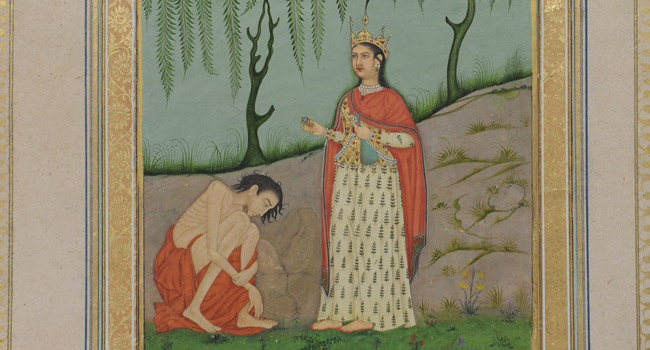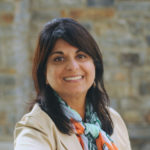“Majnūn Laylā: The Romeo and Juliet of Islamic Civilizations,” by Ruqayya Y. Khan
October 17, 2019
I am passionate about bringing research discoveries into the classroom with students of HMC and the other Claremont Colleges. I especially enjoy drawing out connections among the Abrahamic faith traditions in courses like Islam, Christianity and Judaism. My students and I have been discussing how we can better understand the cultural connections between the Greek and early Islamic cultures, especially the urban culture of 10th-century Baghdad or the so-called “Arabian Nights.” This is also the subject of my latest book, Bedouin and ‘Abbāsid Islamic Cultural Identities: The Arabic Majnūn Laylā Story (Routledge Press), an examination of a renowned Arabic-language, Romeo and Juliet-style love story.
In June 2018, while writing my book, I visited Brussels to watch Orfeo and Majnūn (an opera drawing upon the pre-modern love story Majnūn Laylā) being performed at La Monnaie, Brussels’ beautiful, stately opera house. When I first heard about Orfeo and Majnūn, I was curious about the modern, European “takes” on this famous Middle Eastern love story, and I also wondered why the Greek Orpheus or Orfeo was being paired with the Arab Majnun. The opera was performed in French and Arabic (with Dutch subtitles on electronic screens), and there was a full orchestra.
The Arab version of Romeo and Juliet?
The backdrop on stage consisted of large screens with contemporary, abstract images (e.g., of the earth and moon and other orbs in slate, aqua, black, silver and pale green) accompanied now and then by outsized, white figures of animals in the corners: reindeer, ram, gazelle. In effect, I was witness to a contemporary, hybrid rendition of an operatic Majnūn Laylā that, at times, made me feel like I was watching the Arab version of Romeo and Juliet. At other times, the 1960s American musical Hair came to mind, and yet at other moments, it seemed I was viewing something akin to a classical Greek opera. The audience appeared multicultural and hip, with local school students, native, white Belgians as well as many Belgian-Arabs and Belgian-Africans in attendance.
As I watched this community opera, I felt the twinges of being in the presence of something large, inexpressible and indescribable: the use of myth and symbol to bridge the chasms of so-called East and West; Brussels, marked by segregated neighborhoods of affluent white Belgians and the Arab immigrant quarters; Brussels with growing African and Arab diasporic populations. Watching the opera made me confront thoughts and feelings linked with homeland, death, loss, old age, youth, love, longing, sickness, madness, boredom, passion, dance, magic and more. Is it art? Is it myth? Is it philosophy of love? Orpheo is saying, “You are ravishing my soul ….” Whatever it is, it works, I thought.
Yet, the title Orfeo and Majnūn bewildered me. Then, during winter 2018 as I put the finishing touches on my book manuscript about this classical Arabic love story, I no longer had to wonder why: among the discoveries I made when assessing the Arabic textual material was how much of the story is about the Arab cultural encounter and deep engagement with Greek legacies from antiquity. Granted, there are Greek dimensions in the text of the love story—like the triadic dimensions of love, poetry and madness, and these have been examined. But nobody, critics included, has analyzed the convergence of the historical timelines between the popularization of the romance Majnūn Laylā and the ‘Abbāsid-era translation projects of Greek knowledge to Arabic.
Greek cultures and their legacies
In Bedouin and ‘Abbāsid Islamic Cultural Identities: The Arabic Majnūn Laylā Story, I explore how Greek cultures and their legacies are not just part of the European world but that culturally, these are pivotal to the late antique world of Islam onward into the end of the ‘Abbāsid era. What is thought of as the Greco-Roman world of antiquity is definitely part of the beautiful heritage of the European Renaissance and the Enlightenment, but it also colors the cultural florescence that was part of ‘Abbāsid Bahgdad in the ninth and 10th centuries. Eventually there was a definite Muslim resistance to this Greek “secular” impact, nontheless, this kind of encounter and engagement still remains part of the cultural and literary histories of the early Islamic world.
So how meaningful is it really to think of dualities like Islam vs. the West or the West vs. Islam? What does this really mean and why and how did this kind of worldview and narrative get created and supported?
When the analyses of the famous Middle Eastern love story Majnūn Laylā are paired productively with the contextual timelines of the Greco-Arabian and Greco-Persian, Perso-Arabic intellectual and cultural revolutions that took Baghdad by storm during the ninth, 10th and 11th centuries, the yields are rich and eye-opening.
I hope that readers will also find exciting the discoveries about and insights into ‘Abbāsid Muslim cultural identities, especially male ‘Abbāsid identities. I focus upon how gender and sexuality are employed in the processes of what can be termed “primitivizing” the central male character in the love story, namely Majnūn. I believe the book has relevance to contemporary debates regarding masculinities and femininities as well as those concerning normative sexualities and queer sexualities.
All of the nuances and approaches shape and inform how—even when I teach modern and contemporary material—I love to work in material from the pre-modern world for the benefit of my students.
 Ruqayya Y. Khan is a 2019 visiting professor at HMC and an associate professor and the Malas Chair of Islamic Studies in Claremont Graduate University’s Religion Department. Khan’s research interests include Arabic literary studies (both medieval and modern), Quranic studies, feminist theologies in Islam, Islam and the environment, and the digital age and religion. She teaches courses on Islam, the Qur’an and Middle Eastern literatures at CGU.
Ruqayya Y. Khan is a 2019 visiting professor at HMC and an associate professor and the Malas Chair of Islamic Studies in Claremont Graduate University’s Religion Department. Khan’s research interests include Arabic literary studies (both medieval and modern), Quranic studies, feminist theologies in Islam, Islam and the environment, and the digital age and religion. She teaches courses on Islam, the Qur’an and Middle Eastern literatures at CGU.